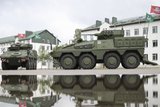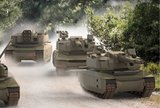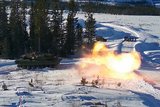US Army tests Hunter, Killer platform
Two new vehicles called the Hunter and Killer were tested during the 2017 Maneuver Fires Integrated Experiment (MFIX) at Fort Sill, the US Army announced on 13 April.
The dune buggy-like vehicles - based on the same platform - are designed to travel through various types of terrain, as well as track aircraft, and perform three-dimensional fires targeting. While still in the very early stages of development, the idea for the vehicles is to operate with high levels of autonomy, supporting the increasing range of operations undertaken by forward observers, from gathering intelligence and performing precision fires to countering enemy UAS. The idea is to make the vehicles highly deployable, including being capable of airdrop from helicopters.
As the vehicles are modular by design, developers can acquire pieces from other systems and merge them on a single platform. The aim is to make parts interchangeable.
The Hunter and Killer vehicles are designed to perform cross-domain functions. For land, the Hunter platform could call precision fires in an automated fashion and air soldiers could use the platform to communicate with an aircraft for support. When performing for maritime, a forward observer could call for an attack from a ship to a target.
The Killer platform would offer the ability to fight in the cyber and space domains. A soldier could request a cyber-call to disrupt communications between an UAS and its operator. The soldiers would also be able to call on space-based capabilities.
Scott Patton, science and technology strategist for the US Army Aviation and Missile Research Development and Engineering Center battlefield operating systems suites team, said: 'We want to see how we can automate the software to reduce the task-saturation of the soldier.
'We want to reduce their workload. We want soldiers just to be forward observers. If they have to get into these other domains, they can do it for a minute or two, let the software do the thinking for them, and then they go back to their domain.'
More from Land Warfare
-
![Hungary set to begin using Hero 400 loitering munitions]()
Hungary set to begin using Hero 400 loitering munitions
Developed by Israel's Uvision and with systems being sold in the thousands to multiple European NATO countries and the US, the Hero family of loitering systems is also in production in the US and Italy, the latter through Rheinmetall.
-
![Croatia orders Leopards and CAESAR howitzers as Lithuania orders more CAESARs]()
Croatia orders Leopards and CAESAR howitzers as Lithuania orders more CAESARs
The Leopard is becoming the tank of choice in central and eastern Europe as Croatia joins Lithuania, the Czech Republic and Hungary in ordering the platform. Lithuania and Croatia have also signed for CAESAR howitzers.
-
![Light Reconnaissance Strike – enabling a vital mission set (Studio)]()
Light Reconnaissance Strike – enabling a vital mission set (Studio)
A new system-of-systems concept will unlock digital integration of sensors and weapons for Light Forces, allowing them to shape the battlefield environment on their own terms and upgrade legacy platforms.






















